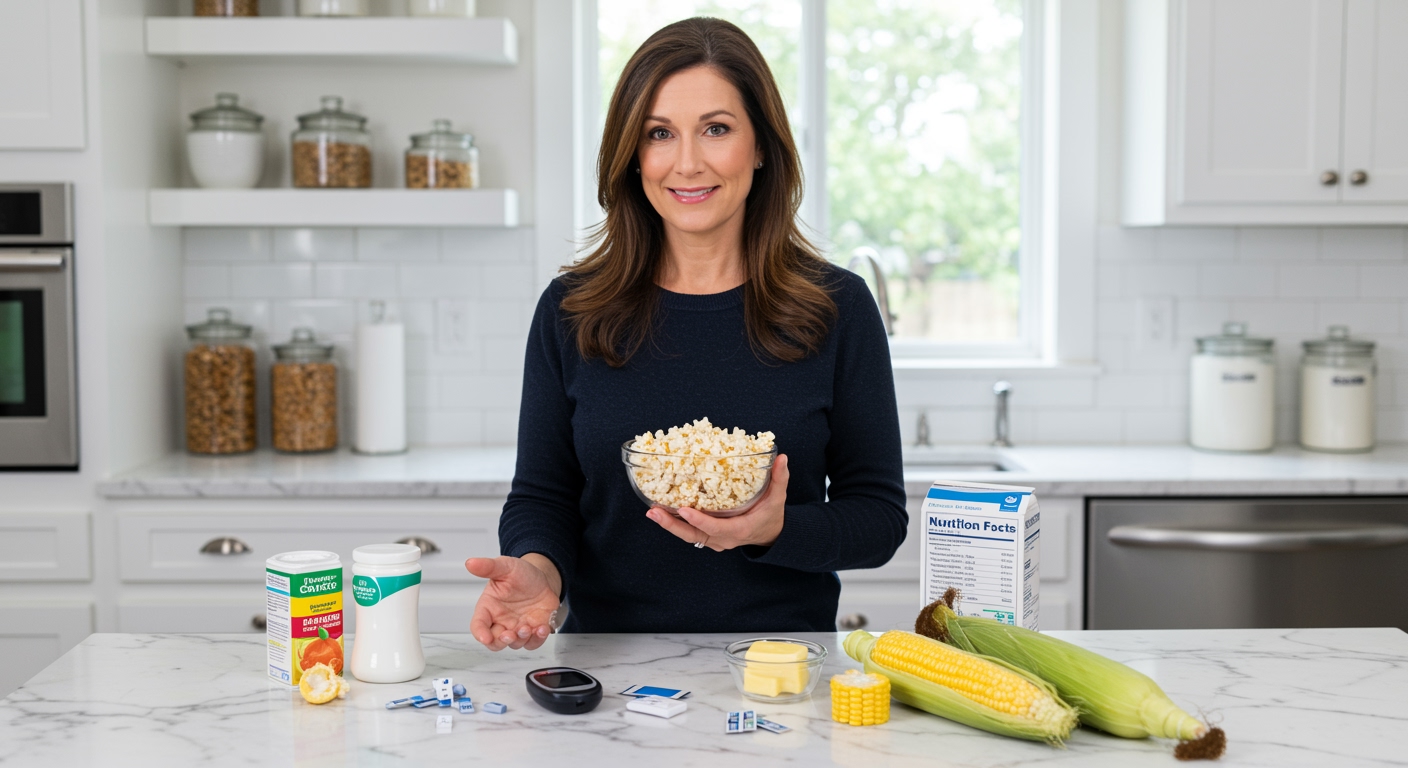✪ Key Takeaway: Plain air-popped popcorn is safe for diabetes when eaten in proper portions due to its whole grain fiber content.
Introduction
You reach for that bowl of popcorn during movie night and suddenly wonder if you are making a terrible mistake for your blood sugar.
Many people with diabetes feel confused about whether this popular snack will send their glucose levels through the roof or if it can actually fit into their meal plan.
Hi, I am Abdur, your nutrition coach and today I am going to explain exactly how popcorn affects your blood sugar and whether you can enjoy it safely with diabetes.
What Makes Popcorn Different From Other Snacks?
Popcorn stands apart from most snack foods because it is actually a whole grain in its natural form.
When you pop corn kernels, you get all three parts of the grain including the fiber-rich bran, the starchy endosperm, and the nutrient-dense germ.
This whole grain structure means popcorn contains about 3.5 grams of fiber per 3-cup serving, which is significantly more than most processed snacks.
The fiber content helps slow down how quickly your body absorbs the carbohydrates, leading to a more gradual blood sugar rise instead of a sharp spike.
Plain air-popped popcorn also has a relatively low calorie density, with only about 30 calories per cup compared to 150 calories in the same amount of potato chips.
✪ Fact: Three cups of air-popped popcorn contain the same amount of fiber as one slice of whole wheat bread.
How Does Popcorn Affect Blood Sugar Levels?
The glycemic index of air-popped popcorn ranges from 65 to 72, which places it in the medium to high category.
However, the glycemic index only tells part of the story because it measures how 50 grams of carbohydrates from a food affects blood sugar.
A more practical measure is the glycemic load, which considers both the glycemic index and the actual amount of carbohydrates you typically eat.
Three cups of popcorn contain only about 18 grams of carbohydrates, giving it a low glycemic load of around 8.
This means that a normal serving of popcorn will cause a much smaller blood sugar increase than the glycemic index number might suggest.
The fiber in popcorn also triggers the release of hormones that help your body use insulin more effectively, further moderating blood sugar responses.
✪ Pro Tip: Eat popcorn with a small amount of protein or healthy fat to further slow carbohydrate absorption.
What About Different Types Of Popcorn?
Not all popcorn is created equal when it comes to blood sugar management.
Air-popped popcorn without added ingredients remains your best choice because it contains no extra sugars, unhealthy fats, or artificial additives.
Movie theater popcorn and many commercial varieties are loaded with butter-flavored oils, salt, and sometimes sugar-based seasonings that can dramatically increase calories and affect blood glucose.
Caramel corn and kettle corn contain significant amounts of added sugars that will cause much larger blood sugar spikes than plain popcorn.
Even microwave popcorn often contains trans fats, excessive sodium, and artificial flavors that provide no nutritional benefit.
If you want flavored popcorn, try adding your own seasonings like nutritional yeast, herbs, spices, or a small amount of olive oil after popping.
✪ Note: One cup of caramel corn contains about 26 grams of sugar compared to zero grams in plain popcorn.
How Much Popcorn Can You Eat With Diabetes?
Portion control remains crucial even with diabetes-friendly foods like plain popcorn.
A reasonable serving size is about 3 cups of popped corn, which provides 18 grams of carbohydrates and fits well into most diabetes meal plans.
This amount allows you to satisfy your craving for a crunchy snack without overwhelming your blood sugar management efforts.
You should count popcorn as a starch exchange in your meal planning, similar to how you would count bread, rice, or pasta.
Some people find that eating popcorn in the evening helps them avoid higher-calorie desserts while still feeling satisfied.
Always monitor your individual blood sugar response to popcorn, as personal tolerance can vary based on your medication, activity level, and overall health status.
✪ Pro Tip: Use a measuring cup to portion your popcorn rather than eating directly from the bag to avoid overconsumption.
The Bottom Line
Plain air-popped popcorn can absolutely be part of a healthy diabetes management plan when you eat appropriate portions and choose varieties without added sugars or unhealthy fats.
Smart snacking means choosing whole foods that provide nutrition along with satisfaction, not just empty calories that spike your blood sugar.
I would love to hear about your experience with popcorn and blood sugar management, so please share your questions or thoughts in the comments below.
References
At NutritionCrown, we use quality and credible sources to ensure our content is accurate and trustworthy. Below are the sources referenced in creating this article:
- SingleCare: Is Popcorn Good for Diabetics?
- Signos: Popcorn Glycemic Index
- Nourish: Popcorn and Diabetes
- Tristate Clinics: Is Popcorn Safe for Diabetics? Exploring Health Benefits and Risks





